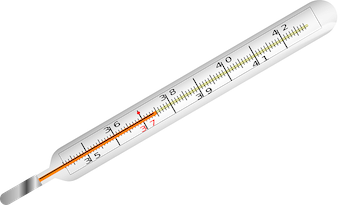Accuracy of Auricular, Axillary, and Rectal Thermometry
How accurately do auricular and axillary temperature measurement match the gold standard of rectal temperature?

Rectal temperature, while currently considered the gold standard for small animal temperature assessment, can be difficult to obtain from patients with rectal disease or an uncooperative temperament. Axillary and auricular temperatures are alternative methods for temperature assessment; however, their reference ranges in dogs are not yet established.
A recent report in the Journal of the American Animal Hospital Association assessed the accuracy of axillary and auricular temperatures in a systemically healthy canine population using rectal temperature as the gold standard comparison.
Study Design
Fifty canine patients admitted for various elective surgical procedures at either the Dallas Veterinary Surgical Center or Oklahoma State University were enrolled in the study. Dogs were declared systemically healthy via physical examination, complete blood count, and serum biochemistry.
RELATED:
- Temperature-Related Physical Modalities for Acute Pain in the ER
- Low Rectal Temperature Linked to Death in Pet Rabbits
Researchers obtained rectal, axillary, and auricular temperatures at 3 time points during hospitalization. Rectal and axillary thermometry, performed sequentially with the same digital thermometer, was followed immediately by auricular temperature measurement with an infrared auricular thermometer. At Oklahoma State University, the 3 time points for temperature measurements included the day of presentation, the day of surgery before premedication was administered, and after full recovery from anesthesia. At Dallas Veterinary Surgical Center, temperature measurements were obtained 10 to 15 minutes after admission, after full recovery from anesthesia, and on the morning of discharge (typically 1 day after surgery).
Results
Study participants included 26 female and 24 male dogs representing over 20 breeds and ranging from 1 to 11 years in age and 4 to 64 kg in weight. Body condition score, recorded for all but 1 dog, averaged 5.8/9 (range, 4-8).
Pearson’s linear correlation coefficient showed that axillary temperature had poor agreement with rectal temperature. Overall, axillary temperature underestimated rectal temperature with an average discrepancy of 1.2°C and a maximum discrepancy of 4.0°C. Only 1 of 50 axillary temperature readings was the same as the rectal temperature, and axillary temperature had an overall sensitivity of 68% and a specificity of 58%.
While auricular temperature agreed more strongly with rectal temperature, the average discrepancy between readings was still 0.6°C, with a maximum difference of 2.2°C. Six of 50 auricular readings were the same as the rectal temperatures, and the method had an overall sensitivity of 75% and a specificity of 76%.
Axillary and auricular temperatures also had poor agreement with each other, with auricular temperatures generally being higher. Axillary temperature decreased as body size increased, but body condition score itself was not correlated with either axillary or auricular temperature.
Take-home Message
The investigators concluded that axillary and auricular temperatures were both poor predictors of rectal temperature in dogs. While auricular temperature is commonly used in human medicine, the method may be less predictable in dogs due to the unique anatomy of the canine ear canal. Nevertheless, auricular temperature was more accurate than axillary temperature and was the suggested method for cases in which rectal temperature cannot be obtained.
Dr. Stilwell received her DVM from Auburn University, followed by a MS in Fisheries and Aquatic Sciences and a PhD in Veterinary Medical Sciences from the University of Florida. She provides freelance medical writing and aquatic veterinary consulting services through her business, Seastar Communications and Consulting.